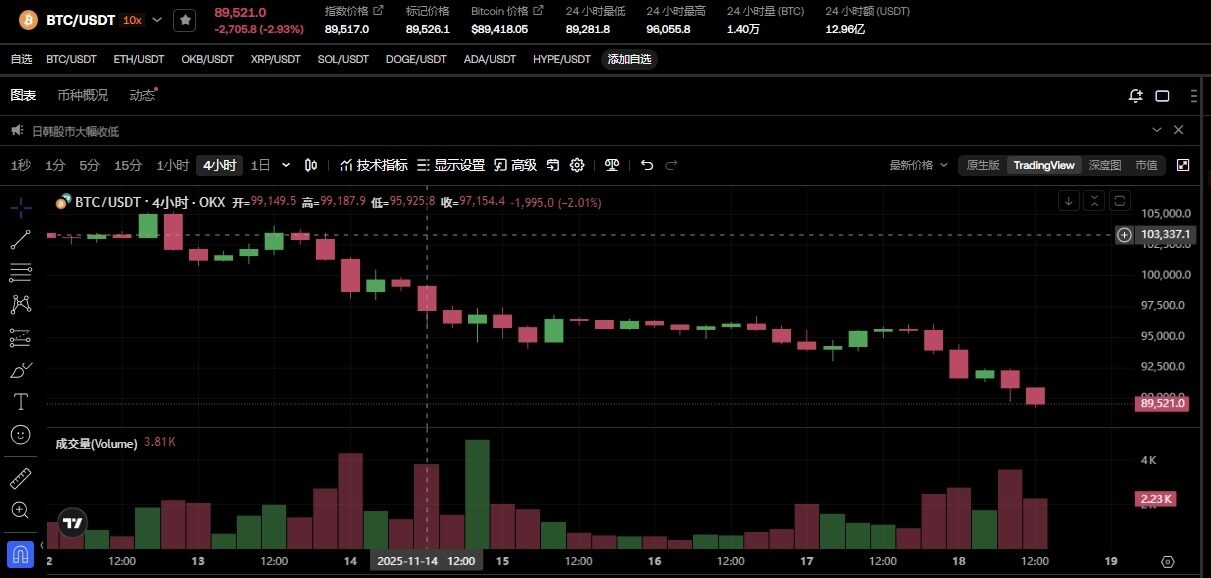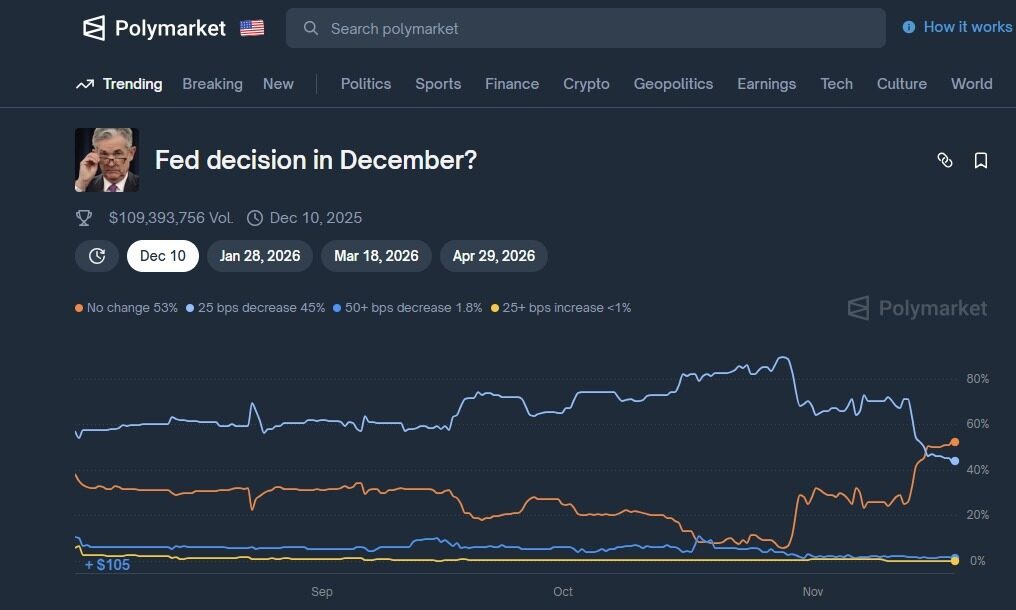Bitcoin breaks below key support level; market prepares for no interest rate cuts.
The cryptocurrency market remained challenging yesterday, with market sentiment continuing to turn cautious.
Both Bitcoin (BTC) and Ethereum (ETH) saw their losses widen, reflecting continued buyer hesitation and dominating selling pressure. Unlike previous crashes, this decline appears more like a steady, controlled correction. This suggests that leverage is gradually decreasing rather than being aggressively liquidated.
Bitcoin's recent price action highlights this pattern. Earlier this week, Bitcoin repeatedly attempted to return to its highs but failed, and momentum subsequently weakened further. As of this writing, Bitcoin is trading between $89,500 and $89,600, down from last week's levels. Ethereum's price action mirrors Bitcoin's, failing to break free from Bitcoin's grasp and unable to find effective support.
The tone of the entire market has shifted: declines are no longer seen as buying opportunities, but rather as triggering silence and caution—indicating fragile market confidence.
Over the past 24 hours: Data confirms market weakness.
Bitcoin prices have continued to fall over the past 24 hours.
The 4-hour chart shows persistent downward pressure accompanied by increasing selling volume. Several brief attempts to rally quickly faded, indicating a lack of buyer confidence. Larger sell orders and rising trading volume suggest that this move may not be solely driven by retail investor sentiment.
Since November 14th, Bitcoin has exhibited a clear price pattern: lower highs, weaker rebounds, and a gradual increase in supply. If this trend continues, traders may shift their focus to deeper structural support areas rather than expecting a rapid price rebound.
The decline did not trigger panic, but it did bring weakness. That alone is enough to unsettle investors who were expecting a stronger rebound by the end of the year.

What Market Leaders Say
Several prominent figures have commented on the current market situation, providing background information beyond the charts.
Fundstrat's Tom Lee attributes the current weakness to the lingering effects of the October 10th deleveraging event. He believes market makers' balance sheets may still be damaged, creating a temporary liquidity shortage similar to the quantitative tightening in the cryptocurrency sector. However, Lee maintains that the current cycle has not yet reached its final peak, noting that the true top may not arrive for another one to three years.

Arthur Hayes holds a more cautious view. He points out that the decline in Bitcoin while the stock market remains high may indicate brewing credit pressures. His liquidity model shows a weakening dollar. If liquidity tightens further before policymakers intervene, Bitcoin's price could fall to above $80,000. However, Hayes believes that once liquidity recovers, Bitcoin is still poised for a strong long-term upward trend.
Cathy Wood remains optimistic about Bitcoin as an asset class. While acknowledging competition within the ecosystem—particularly from stablecoins—she still views Bitcoin as a long-term macro asset, rather than a speculative cyclical product.
These views take into account that the weakness is likely structural rather than emotional—driven by liquidity mechanisms rather than by weakening confidence.
The Fed's December decision will have a significant impact on market sentiment.
The uncertainty surrounding the Federal Reserve's upcoming decision has become another source of pressure.
The probability of no interest rate cut in December has increased significantly, and this has become the general expectation of traditional markets and forecasting platforms. Despite recent political turmoil, traders seem to be paying more attention to data and central bank communications.
This shift is significant for asset classes closely tied to liquidity conditions. Prolonged high interest rates dampen speculative appetite, reduce leverage, and accelerate risk aversion – all of which are now evident in the digital asset market.

Is this the bottom of the market?
It seems premature to declare the market has bottomed out. The current market environment lacks the typical characteristics of the end of a cycle: forced liquidation, capitulation selling, extreme panic, or severe valuation misalignment. Instead, the market appears to be slowly declining, seeking stability amidst continued liquidity contraction.
This doesn't mean that long-term investment strategies have become ineffective. Rather, it means that timing is crucial—rushing into the market based on assumptions rather than signals increases risk.
Looking to the future
At present, proceeding cautiously may be more appropriate than aggressively building positions. Gradual building of positions, maintaining flexibility, and avoiding leverage may be wiser in the coming weeks.
The next round of expansion is inevitable—but the market may need a winter period to regain momentum. Until then, patience is not a sign of weakness.
This is self-discipline.
- 核心观点:加密货币市场正经历结构性回调。
- 关键要素:
- 比特币以太坊持续下跌,反弹乏力。
- 杠杆稳步降低,未现恐慌性抛售。
- 流动性收缩是主要驱动因素。
- 市场影响:短期投机情绪受抑制,长期投资需耐心。
- 时效性标注:短期影响



